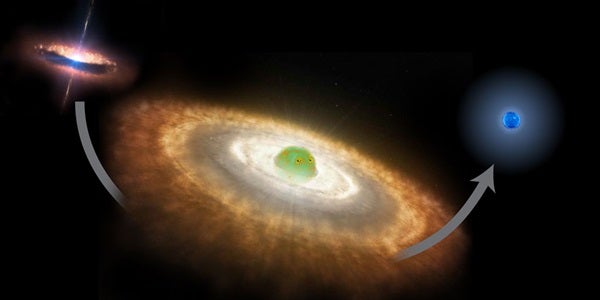For many years, it has been a challenge to obtain a clear spectrum of a massive star still in the process of formation. The reason is that forming stars are deeply embedded inside their parental clouds that obscure their birthplaces from view. Recently, a spectrum has been obtained of the young star B275 in the Omega Nebula (M17) with the new, powerful spectrograph X-shooter on the European Southern Observatory’s Very Large Telescope in Chile. This has resulted in the first firm spectral classification of a massive star on its way to the main sequence.
The spectrum indicates that B275 is about three times as large as a normal main-sequence star, which is about seven times more massive than our Sun. This is in agreement with the predictions of current star formation models.
At an earlier phase in the formation process, a rotating gaseous disk surrounds young massive stars, feeding the forming star. This mass-accretion process is physically complicated and poorly understood, and it is often accompanied by the presence of strong jets.
When the accretion process is finished, the surrounding disk disappears and the surface of the new star becomes visible; B275 has entered this phase. The core temperature of the new star is now high enough for hydrogen fusion to commence. The star further contracts until the energy production in the core exactly compensates the radiation losses at the stellar surface and a stable equilibrium has been reached.
The X-shooter spectrum indicates that the surface temperature of the massive young star B275 is significantly lower than usual for such a luminous star — 1,600 times more luminous than the Sun, the luminosity of a 7-solar-mass star. Assigning a larger radius to the star solves this discrepancy. That is exactly what the sharp spectral lines of B275 demonstrate: the spectrum of a giant star.
“The large wavelength coverage of X-shooter provides the opportunity to determine many stellar properties at once, like the surface temperature, size, and the presence of a disk,” said Bram Ochsendorf from the University of Amsterdam.
Rolf Chini and Vera Hofmeisster from the Ruhr-Univeersitaet in Bochum, Germany, obtained the spectrum of B275 during the X-shooter science verification process. “This is a beautiful confirmation of new theoretical models describing the formation process of massive stars, obtained thanks to the extreme sensitivity of X-shooter,” said Lex Kaper from the University of Amsterdam.
For many years, it has been a challenge to obtain a clear spectrum of a massive star still in the process of formation. The reason is that forming stars are deeply embedded inside their parental clouds that obscure their birthplaces from view. Recently, a spectrum has been obtained of the young star B275 in the Omega Nebula (M17) with the new, powerful spectrograph X-shooter on the European Southern Observatory’s Very Large Telescope in Chile. This has resulted in the first firm spectral classification of a massive star on its way to the main sequence.
The spectrum indicates that B275 is about three times as large as a normal main-sequence star, which is about seven times more massive than our Sun. This is in agreement with the predictions of current star formation models.
At an earlier phase in the formation process, a rotating gaseous disk surrounds young massive stars, feeding the forming star. This mass-accretion process is physically complicated and poorly understood, and it is often accompanied by the presence of strong jets.
When the accretion process is finished, the surrounding disk disappears and the surface of the new star becomes visible; B275 has entered this phase. The core temperature of the new star is now high enough for hydrogen fusion to commence. The star further contracts until the energy production in the core exactly compensates the radiation losses at the stellar surface and a stable equilibrium has been reached.
The X-shooter spectrum indicates that the surface temperature of the massive young star B275 is significantly lower than usual for such a luminous star — 1,600 times more luminous than the Sun, the luminosity of a 7-solar-mass star. Assigning a larger radius to the star solves this discrepancy. That is exactly what the sharp spectral lines of B275 demonstrate: the spectrum of a giant star.
“The large wavelength coverage of X-shooter provides the opportunity to determine many stellar properties at once, like the surface temperature, size, and the presence of a disk,” said Bram Ochsendorf from the University of Amsterdam.
Rolf Chini and Vera Hofmeisster from the Ruhr-Univeersitaet in Bochum, Germany, obtained the spectrum of B275 during the X-shooter science verification process. “This is a beautiful confirmation of new theoretical models describing the formation process of massive stars, obtained thanks to the extreme sensitivity of X-shooter,” said Lex Kaper from the University of Amsterdam.










